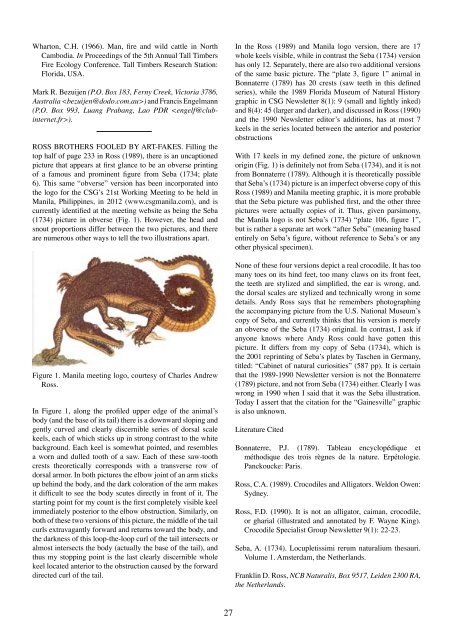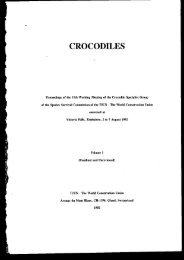size: 992KB - Crocodile Specialist Group
size: 992KB - Crocodile Specialist Group
size: 992KB - Crocodile Specialist Group
You also want an ePaper? Increase the reach of your titles
YUMPU automatically turns print PDFs into web optimized ePapers that Google loves.
Wharton, C.H. (1966). Man, fire and wild cattle in North<br />
Cambodia. In Proceedings of the 5th Annual Tall Timbers<br />
Fire Ecology Conference. Tall Timbers Research Station:<br />
Florida, USA.<br />
Mark R. Bezuijen (P.O. Box 183, Ferny Creek, Victoria 3786,<br />
Australia ) and Francis Engelmann<br />
(P.O. Box 993, Luang Prabang, Lao PDR ).<br />
ROSS BROTHERS FOOLED BY ART-FAKES. Filling the<br />
top half of page 233 in Ross (1989), there is an uncaptioned<br />
picture that appears at first glance to be an obverse printing<br />
of a famous and prominent figure from Seba (1734; plate<br />
6). This same “obverse” version has been incorporated into<br />
the logo for the CSG’s 21st Working Meeting to be held in<br />
Manila, Philippines, in 2012 (www.csgmanila.com), and is<br />
currently identified at the meeting website as being the Seba<br />
(1734) picture in obverse (Fig. 1). However, the head and<br />
snout proportions differ between the two pictures, and there<br />
are numerous other ways to tell the two illustrations apart.<br />
Figure 1. Manila meeting logo, courtesy of Charles Andrew<br />
Ross.<br />
In Figure 1, along the profiled upper edge of the animal’s<br />
body (and the base of its tail) there is a downward sloping and<br />
gently curved and clearly discernible series of dorsal scale<br />
keels, each of which sticks up in strong contrast to the white<br />
background. Each keel is somewhat pointed, and resembles<br />
a worn and dulled tooth of a saw. Each of these saw-tooth<br />
crests theoretically corresponds with a transverse row of<br />
dorsal armor. In both pictures the elbow joint of an arm sticks<br />
up behind the body, and the dark coloration of the arm makes<br />
it difficult to see the body scutes directly in front of it. The<br />
starting point for my count is the first completely visible keel<br />
immediately posterior to the elbow obstruction. Similarly, on<br />
both of these two versions of this picture, the middle of the tail<br />
curls extravagantly forward and returns toward the body, and<br />
the darkness of this loop-the-loop curl of the tail intersects or<br />
almost intersects the body (actually the base of the tail), and<br />
thus my stopping point is the last clearly discernible whole<br />
keel located anterior to the obstruction caused by the forward<br />
directed curl of the tail.<br />
In the Ross (1989) and Manila logo version, there are 17<br />
whole keels visible, while in contrast the Seba (1734) version<br />
has only 12. Separately, there are also two additional versions<br />
of the same basic picture. The “plate 3, figure 1” animal in<br />
Bonnaterre (1789) has 20 crests (saw teeth in this defined<br />
series), while the 1989 Florida Museum of Natural History<br />
graphic in CSG Newsletter 8(1): 9 (small and lightly inked)<br />
and 8(4): 45 (larger and darker), and discussed in Ross (1990)<br />
and the 1990 Newsletter editor’s additions, has at most 7<br />
keels in the series located between the anterior and posterior<br />
obstructions<br />
With 17 keels in my defined zone, the picture of unknown<br />
origin (Fig. 1) is definitely not from Seba (1734), and it is not<br />
from Bonnaterre (1789). Although it is theoretically possible<br />
that Seba’s (1734) picture is an imperfect obverse copy of this<br />
Ross (1989) and Manila meeting graphic, it is more probable<br />
that the Seba picture was published first, and the other three<br />
pictures were actually copies of it. Thus, given parsimony,<br />
the Manila logo is not Seba’s (1734) “plate 106, figure 1”,<br />
but is rather a separate art work “after Seba” (meaning based<br />
entirely on Seba’s figure, without reference to Seba’s or any<br />
other physical specimen).<br />
None of these four versions depict a real crocodile. It has too<br />
many toes on its hind feet, too many claws on its front feet,<br />
the teeth are stylized and simplified, the ear is wrong, and.<br />
the dorsal scales are stylized and technically wrong in some<br />
details. Andy Ross says that he remembers photographing<br />
the accompanying picture from the U.S. National Museum’s<br />
copy of Seba, and currently thinks that his version is merely<br />
an obverse of the Seba (1734) original. In contrast, I ask if<br />
anyone knows where Andy Ross could have gotten this<br />
picture. It differs from my copy of Seba (1734), which is<br />
the 2001 reprinting of Seba’s plates by Taschen in Germany,<br />
titled: “Cabinet of natural curiosities” (587 pp). It is certain<br />
that the 1989-1990 Newsletter version is not the Bonnaterre<br />
(1789) picture, and not from Seba (1734) either. Clearly I was<br />
wrong in 1990 when I said that it was the Seba illustration.<br />
Today I assert that the citation for the “Gainesville” graphic<br />
is also unknown.<br />
Literature Cited<br />
Bonnaterre, P.J. (1789). Tableau encyclopédique et<br />
méthodique des trois règnes de la nature. Erpétologie.<br />
Panckoucke: Paris.<br />
Ross, C.A. (1989). <strong>Crocodile</strong>s and Alligators. Weldon Owen:<br />
Sydney.<br />
Ross, F.D. (1990). It is not an alligator, caiman, crocodile,<br />
or gharial (illustrated and annotated by F. Wayne King).<br />
<strong>Crocodile</strong> <strong>Specialist</strong> <strong>Group</strong> Newsletter 9(1): 22-23.<br />
Seba, A. (1734). Locupletissimi rerum naturalium thesauri.<br />
Volume 1. Amsterdam, the Netherlands.<br />
Franklin D. Ross, NCB Naturalis, Box 9517, Leiden 2300 RA,<br />
the Netherlands.<br />
27

















